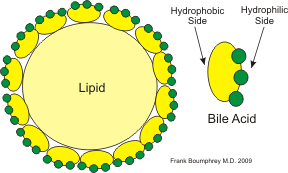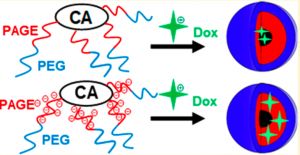Breast cancer is the second common cancer in Canada. Chemotherapy is one of the main treatments for breast cancer which involves severe side effects. Doxorubicin is the current chemotherapy medication used for breast cancer. Professor Zhu and Alexander are developing a drug delivery system to encapsulate chemotherapeutic agents to increase their safety and transport efficacy. The interesting aspect of their research is that they are using the body’s own natural component, the “bile acid” in the design of drug carrier systems and their recent study is the use of bile acids as a doxorubicin carrier for breast cancer.
Recently, I had the pleasure to talk with professor Xiaxia Zhu and his Ph.D. student Mr. Alexander Cunningham about their recent article “Bile Acid-Based Drug Delivery Systems for Enhanced Doxorubicin Encapsulation: Comparing Hydrophobic and Ionic Interactions in Drug Loading and Release”.

Professor Zhu’s background is polymer chemistry. He has been a professor in the department chemistry at the University of Montreal since 1992. He also holds the Canada Research Chair in polymeric biomaterials.
Alexander holds a BSc degree in biochemistry. He completed his MSc in chemistry: “I worked on nanoparticles for drug delivery systems, it mostly involved the synthesis of polymers and I really enjoyed it. Alexander explains: ”After graduation, I heard about professor Zhu, as he is very well known in this field.” Alexander started his Ph.D. under the supervision of professor Zhu and continues his study on nanotechnology drug delivery systems. Professor Zhu and Alexander also work on joint projects with the pharmacy department at the University of Montreal.
Professor Zhu went on to explain that Alexander is a good fit to the project: “He also has some knowledge in biochemistry. That’s why he can easily integrate the chemistry part in my lab with the biomedical pharmaceutical studies in the faculty of pharmacy. I think that he learned a lot throughout the courses and now he is doing a bit more chemistry than biochemistry, but he manages the situation very well.”
Chemotherapy drawbacks
Alexander explains some drawbacks of the current drug delivery systems in cancer. He states that a lot of research is being conducted on drug delivery systems because it has been estimated that about 47% of the active pharmaceutical ingredients have a hydrophobic character, which affects the pharmacokinetics of the drug. Hydrophobic drugs have low dissolution in aqueous environments such as the human body and are poorly absorbed in the target site, which reduces their efficacy. Chemotherapy drugs also possess this hydrophobic character and have a very toxic active pharmaceutical ingredient, resulting in severe side effects. To have a high efficacy of the chemotherapeutic agents, a higher dose of the drug is required for the drug to be delivered successfully at the specific tumour site. This high dose of the drug then raises toxicity in the patient’s body. Due to the hydrophobic property of the chemotherapy drug and its low efficacy at low dosage, several studies have been conducted to find a drug delivery system that is able to encapsulate the drug and deliver it specifically to a targeted tissue which can alleviate the toxicity and increase the viability of the drug.
What is special about bile acids?
Nanoparticles are utilized as drug carriers that are able to encapsulate large amounts of the drug, but the toxic response of the body generated from these particles limits their application. Therefore, to reduce the number of particles, higher drug loading capacity is desired.
Alexander explained that the two current nanoparticle materials used for drug delivery systems are liposomes and polymer-based systems, each with its own advantages and disadvantages. For polymers, the main advantage is their low-cost production and the greater versatility. Furthermore, they are more biocompatible because of their increased system stability compared to liposome-based methods.
Micelles are a unit structure built up from polymeric molecules or ions, they contain hydrophobic heads that form the inner part while their hydrophilic heads form the surface of the micelle in contact with water. Bile acids are naturally synthesized in the gallbladder of the human body and their main role is to form micelles in the intestine with the fat and lipids obtained from the diet leading to their absorption. In recent years, bile acids have been used in the field of drug delivery systems as absorption enhancers.

Our body is an aqueous system and about 60% of the adult body is water. With each meal, a lot of oil and lipids enter our body. We need bile acids to the in the food otherwise the fat will stick to our intestine wall, which can be a precursor to cancer. Therefore, we need bile acids to dissolve the fat which will be absorbed and secreted.

Bile acid in drug delivery
Professor Zhu and Alexander have used the intrinsic capacity of bile acids to form micelles and have optimized the micellization of bile acids to encapsulate chemotherapeutic agents such as doxorubicin and deliver them to the cancer tissue. They have increased the drug loading of bile acids by forming a reservoir through their aggregation process.
Professor Zhu explains that it is essential to use the natural compounds, already existing in our body, to make the polymers. In their recent study, they used bile acids in drug delivery systems to prevent the toxic response of the body. To stabilize the micelles, they formed bile acid-based block copolymers by using the anionic polymerization technique. Professor Zhu describes the technique as a difficult experiment, for which Alexander has developed a special skill, becoming an expert in the synthesis of this type of polymer. Professor Zhu mentioned that he often tells his students, “If you can do an anionic synthesis of bile acids, you can do any kind of chemistry.”

He clarifies that the bile acid micelles are not designed to degrade in the body. They are individual molecules that can aggregate. After delivering the anti-tumour drug, they will dissociate in the patient’s body.
He explained that they have not tested the bile acid drug delivery system on animal models yet but only on cell cultures since they are cheaper and if they succeed in achieving effective drug delivery, they will extend it to animal models.
Alexander added that they plan to study the drug delivery system on MCF-7 cancer cell lines in the future. The MCF-7 cell line is the main experimental model for breast cancer. Usually, in the course of chemotherapy treatment, a patient will be given a drug and more often than not the cancer cells will evolve and develop a mutation that affects the multidrug-resistant gene, which then induces cell resistance to the chemotherapy treatment. In this case, when a drug is injected alone, it would not reach the target cancer cell and as soon as the drug enters the cells, it will be pushed out. The main advantage of having nanoparticles as a drug delivery system is that they are not as easily ejected from the cells, thus making the drug more effective.
Professor Zhu has also used bile acids for antifungal drug delivery systems: “We tested the drug delivery on mice and we were able to improve it by increasing the bioavailability of the antifungal drug by 10-fold.”
Future applications of bile acids
Professor Zhu explains “Drug development is our priority at the moment but in the future maybe we can use it in cosmetics. We have modified bile acids to a more stable form. Bile acid derived detergents can be used for skin allergies, it may be a bit more expensive than the average soap but for certain situations it can be useful.”
Responses from the scientific community
Professor Zhu describes the response he receives from the scientific community: “When we go to conferences to present the data, we see people are interested in our research. They like the novelty of the system. Not a lot of research has been done on using bile acids in materials. Actually, we are pioneers working on this, and probably we can claim that we have published the most papers in this area than anyone else. That’s why we collaborate with other colleagues because they think it’s an interesting system to use and they want to try this drug delivery system.”
